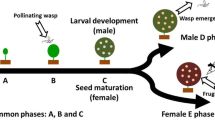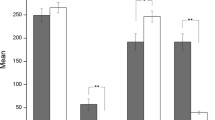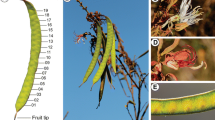Summary
Ficus can only reproduce if they are pollinated by mutualistic wasps that breed within the figs. Pollen-loaded wasps enter the figs when the female flowers are receptive. Several weeks later, their offspring load pollen within the fig and then emerge. As individual trees typically produce crops of synchronous figs at long intervals, the shortlived wasps have to move to another, receptive, tree. The wasp population can only survive, and hence the fig population reproduce, if there are trees fruiting all over the year. When only few trees are present within a population gaps in the flowering sequence may lead to the extinction of the local pollinator population. Two models are presented. One investigates the number of trees necessary in order to sustain a local pollinator population when the tree population has a seasonal pattern of fruiting. The second model investigates how such a seasonal pattern may evolve within a fig population as a result of individual selection on the trees. It is shown that pollinator populations are fragilized under seasonal conditions. Hence, the breeding system ofFicus limits their expansion into highly seasonal habitats. Seasonal habitats may also lead to seasonal adjustment of male versus female investments and to the evolution of dioecy.
Similar content being viewed by others
References
Berg, C. C., Floral differentiation and dioecism inFicus (Moraceae), in: Minisymposium: Figs and Fig Insects, pp. 15–25. Eds F. Kjellberg and G. Valdeyron. CNRS, Montpellier, France 1984.
Bronstein, J. L., Maintenance of species-specificity in a neotropical fig-pollinator wasp mutualism. Oikos48 (1987) 39–46.
Bronstein, J. L., A mutualism at the edge of its range. Experientia45 (1989) 622–637.
Galil, J., Fig biology. Endeavor, New Series1 (1977) 52–56.
Hill, D. S., Figs of Hong Kong, Hong Kong University Press, Hong Kong 1967.
Janzen, D., How to be a fig. A. Rev. Ecol. Syst.10 (1979) 13–15.
Kjellberg, F., Doumesche, B., and Bronstein, J. L., Longevity of a fig wasp (Blastophaga psenes). Proc. K. Ned. Akad. Wet. (C)91 (1988) 117–122.
Kjellberg, F., Gouyon, P. H., Ibrahim, M., Raymond, M., and Valdeyron, G., The stability of the symbiosis between dioecious figs and their pollinators: a study ofFicus carica L. andBlastophaga psenes L. Evolution41 (1987) 693–704.
Kjellberg, F., and Valdeyron, G., Species-specific pollination: a help or a limitation to range extension? in: Biological Invasions in Europe and the Mediterranean Basin. Eds F. di Castri and A. J. Hansen. Dr W Junk publishers (1989) in press.
Michaloud, G., Aspects de la reproduction des figuiers monoiques en forêt tropicale. Thèse d'Université, USTL, Montpellier, France 1988.
Milton, K., Windsor, D. M., Morrisson, D. W., and Estribi, M. A., Fruiting phenology of two neotropicalFicus species. Ecology63 (1982) 752–762.
Verkerke, W., Structure and function of the fig. Experientia45 (1989) 612–622.
Author information
Authors and Affiliations
Rights and permissions
About this article
Cite this article
Kjellberg, F., Maurice, S. Seasonality in the reproductive phenology ofFicus: Its evolution and consequences. Experientia 45, 653–660 (1989). https://doi.org/10.1007/BF01975682
Issue Date:
DOI: https://doi.org/10.1007/BF01975682




